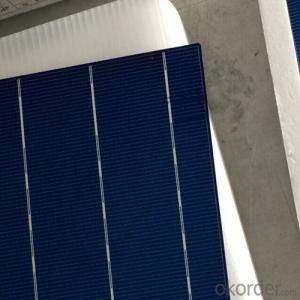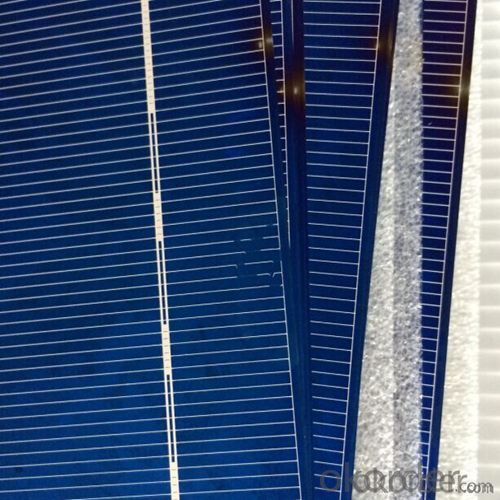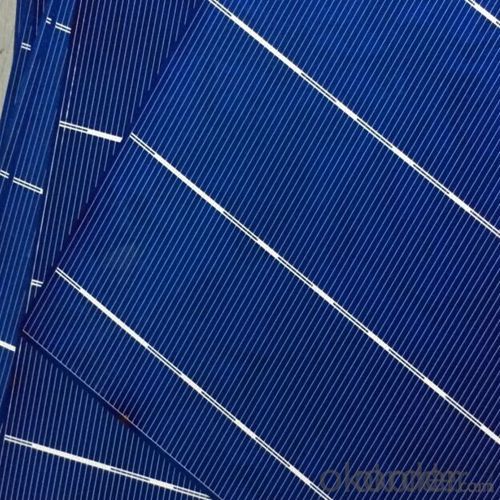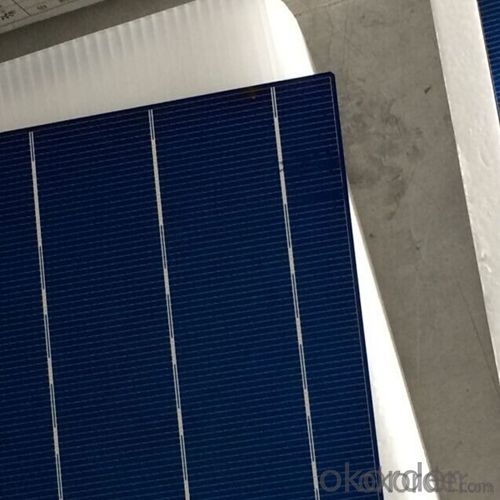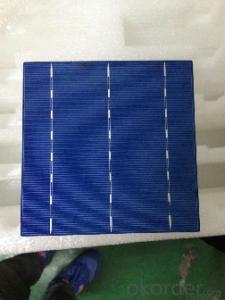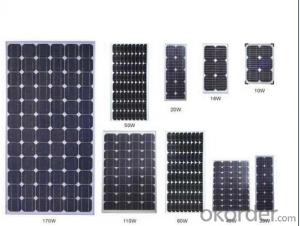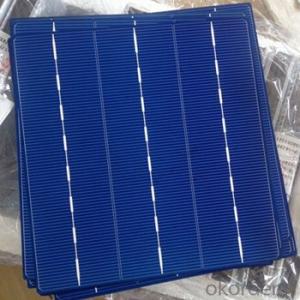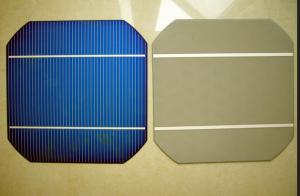Jinko Solar Cells - Not Broken with Low Price and High Efficiency
- Loading Port:
- Shanghai
- Payment Terms:
- TT or LC
- Min Order Qty:
- 30000 pc
- Supply Capability:
- 1000000 pc/month
OKorder Service Pledge
OKorder Financial Service
You Might Also Like
Product description
Solar Cells Not Broken with Low Price and Gigh EFF
A solar cell, or photovoltaic cell, is an electrical device that converts the energy of light directly into electricity by the photovoltaic effect, which is a physical and chemical phenomenon.[1] It is a form of photoelectric cell, defined as a device whose electrical characteristics, such as current, voltage, or resistance, vary when exposed to light. Solar cells are the building blocks of photovoltaic modules, otherwise known as solar panels.
Solar cells are described as being photovoltaic irrespective of whether the source is sunlight or an artificial light. They are used as a photodetector (for example infrared detectors), detecting light or other electromagnetic radiation near the visible range, or measuring light intensity.
In contrast, a solar thermal collector supplies heat by absorbing sunlight, for the purpose of either direct heating or indirect electrical power generation from heat. A "photoelectrolytic cell" (photoelectrochemical cell), on the other hand, refers either to a type of photovoltaic cell (like that developed by Edmond Becquerel and modern dye-sensitized solar cells), or to a device that splits water directly into hydrogen and oxygen using only solar illumination.
Advantage Of Solar Cells Not Broken with Low Price and Gigh EFF
1: High quality cell, Level A cell (14%—17.5%)
2.Dimensione:156*156mm Diagonal:200mm
3: Qualified certification: TUV,CE certification.
4: Warranty: five years for whole unit
Usage/Application Of Solar Cells Not Broken with Low Price and Gigh EFF
1.The absorption of light, generating either electron-hole pairs or excitons.
2.The separation of charge carriers of opposite types.
3.The separate extraction of those carriers to an external circuit.
Product Images
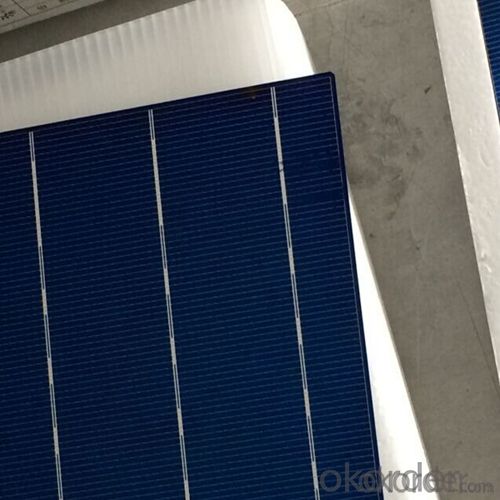
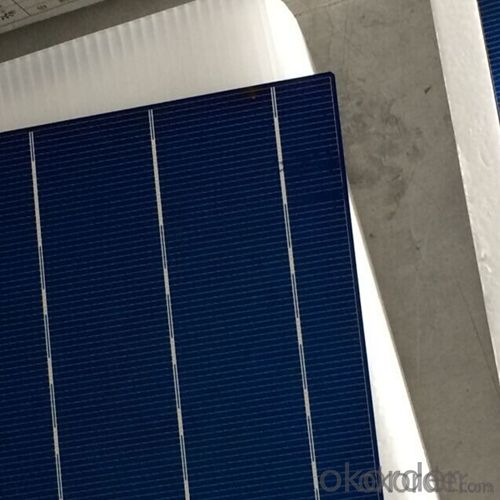
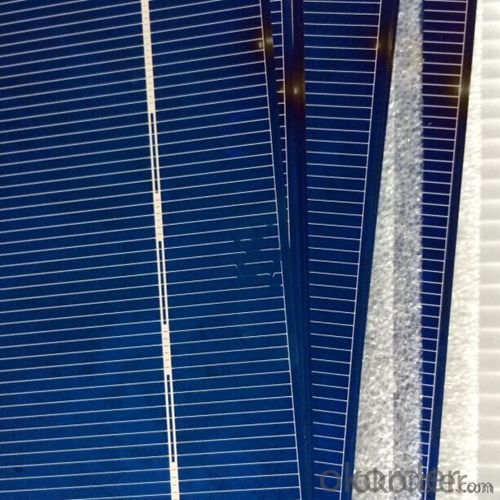
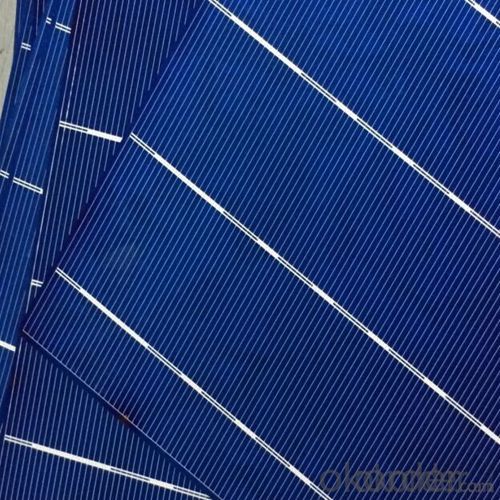
Electrical Characteristic
Efficiency (%) | Pmpp (W) | Umpp (V) | Impp (A) | Uoc (V) | Isc (A) | FF (%) |
17.25 | 4.197 | 0.524 | 7.992 | 0.62 | 8.458 | 80.03% |
17 | 4.137 | 0.524 | 7.876 | 0.619 | 8.353 | 80.01% |
16.75 | 4.076 | 0.522 | 7.81 | 0.617 | 8.286 | 79.73% |
16.5 | 4.015 | 0.518 | 7.746 | 0.613 | 8.215 | 79.73 |
16.25 | 3.955 | 0.515 | 7.683 | 0.61 | 8.144 | 79.61% |
16 | 3.894 | 0.512 | 7.613 | 0.608 | 8.075 | 79.31% |
15.75 | 3.833 | 0.51 | 7.534 | 0.605 | 8.058 | 78.62% |
15.5 | 3.772 | 0.508 | 7.453 | 0.604 | 8.02 | 77.87% |
15.25 | 3.771 | 0.505 | 7.35 | 0.604 | 9.997 | 76.83% |
15 | 3.65 | 0.503 | 7.271 | 0.604 | 7.989 | 75.64% |
14.5 | 3.529 | 0.499 | 7.067 | 0.604 | 7.988 | 73.14% |
14 | 3.407 | 0.499 | 6.833 | 0.604 | 7.833 | 72.01% |
Intensity Dependence
Intensity [W/m2] | Isc× [mA] | Voc× [mV] |
1000 | 1.00 | 1.000 |
900 | 0.90 | 0.989 |
500 | 0.50 | 0.963 |
300 | 0.30 | 0.939 |
200 | 0.20 | 0.920 |
Packaging & Delivery Of Poly Solar Cell 156mm | |
Packaging Detai | Packaging Detail:Export Carton and Pallet or under customer request. |
Delivery Detail:10-20days | |
FAQ
Q:What price for each watt?
A:It depends on the quantity, delivery date and payment terms
Q:What is your warranty system?
A:Our Solar cells performance guarantees for 25 years
Q:How do you pack your products?
A:We have rich experience on how to pack thecells to make sure the safety on shipment when it arrives at the destination.
- Q: Can solar cells be used in recreational vehicles?
- Yes, solar cells can be used in recreational vehicles. Installing solar panels on RVs allows them to harness the power of the sun to generate electricity, which can be used to charge batteries and power appliances while on the road. This helps to reduce reliance on traditional power sources, making RVs more energy-efficient and environmentally friendly.
- Q: What is the role of disconnect switches in solar cell systems?
- Disconnect switches in solar cell systems serve as a critical safety feature. Their role is to provide a means of disconnecting the solar panels from the rest of the system, including the inverter and electrical grid. This is essential during maintenance, repairs, or emergencies to ensure the safety of technicians and prevent electrical shocks or fires. Additionally, disconnect switches allow for isolation of the solar panels from the grid during power outages, preventing the flow of electricity into the grid, thus protecting utility workers from potential harm.
- Q: How do solar cells perform in mountainous regions?
- Solar cells can perform well in mountainous regions, especially if they are strategically placed to maximize exposure to sunlight. However, the performance of solar cells can vary depending on the altitude, slope, and orientation of the panels. It is important to consider factors such as shading from nearby peaks or trees, as well as the potential for snow cover during winter months. Overall, with proper planning and installation, solar cells can effectively generate electricity in mountainous regions.
- Q: What is the impact of fire hazards on solar cells?
- The impact of fire hazards on solar cells can be significant and detrimental. Fires can cause direct damage to the cells, resulting in their complete destruction or impaired performance. The high temperatures and flames associated with fires can melt or warp the delicate components of solar cells, rendering them useless. Additionally, the smoke and ash produced by fires can settle on the surface of the solar panels, reducing their efficiency by blocking sunlight. Therefore, fire hazards pose a significant risk to the functionality and longevity of solar cells.
- Q: Can solar cells be used in boats or marine applications?
- Yes, solar cells can be used in boats or marine applications. Solar panels can be installed on the deck or roof of a boat to harness the power of the sun and convert it into electricity. This electricity can then be used to power various onboard systems such as lights, navigation equipment, communication devices, and even recharge batteries. Solar power offers a sustainable and environmentally-friendly energy solution for boats, reducing reliance on traditional fuel sources and minimizing the carbon footprint of marine activities.
- Q: What is the impact of bird nesting on solar cell performance?
- Bird nesting can have a negative impact on solar cell performance as it can lead to shading, blocking sunlight from reaching the cells and reducing their efficiency. Additionally, bird droppings can accumulate on the surface of the solar panels, further decreasing their output. Regular maintenance and cleaning are essential to minimize the impact of bird nesting on solar cell performance.
- Q: How do solar cells handle power factor correction?
- Solar cells do not handle power factor correction directly. Power factor correction is typically handled by other components in a solar power system, such as inverters or power conditioning units. These components are responsible for converting the DC power generated by solar cells into AC power that can be used in electrical systems. Power factor correction is important to ensure efficient utilization of electrical power and reduce energy losses in the system.
- Q: What is the internal structure of solar panels
- In addition to the quality of EVA itself, the components of the manufacturers of the laminated process is also very large, such as EVA glue degree is not up to standard, EVA and tempered glass, backplane bonding strength is not enough, will cause EVA early aging, Affect component life.
- Q: How do solar cells perform in areas with high levels of sandstorms?
- Solar cells may face challenges in areas with high levels of sandstorms. The sand particles in the air during a sandstorm can potentially cover the surface of solar panels, reducing their efficiency. Moreover, sandstorms may also cause physical damage to the solar cells and their supporting structures. Therefore, it is crucial to implement proper maintenance and protection measures, such as regular cleaning and the use of protective coatings, to ensure optimal performance of solar cells in areas prone to sandstorms.
- Q: How do solar cells perform in different geographic locations?
- Solar cells perform differently in different geographic locations due to variations in sunlight intensity, temperature, and weather patterns. Regions closer to the equator generally receive more direct sunlight throughout the year, resulting in higher solar cell performance. However, solar cells can still generate electricity even in regions with less sunlight, as long as they receive sufficient irradiance. Factors like cloud cover, air pollution, and shading from buildings or trees can also affect solar cell performance. Overall, solar cells can be effective in a wide range of geographic locations, but their output may vary depending on local conditions.
Send your message to us
Jinko Solar Cells - Not Broken with Low Price and High Efficiency
- Loading Port:
- Shanghai
- Payment Terms:
- TT or LC
- Min Order Qty:
- 30000 pc
- Supply Capability:
- 1000000 pc/month
OKorder Service Pledge
OKorder Financial Service
Similar products
Hot products
Hot Searches
Related keywords
